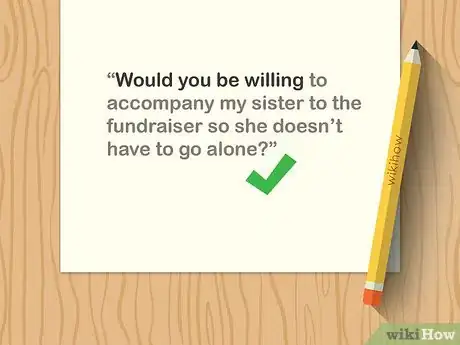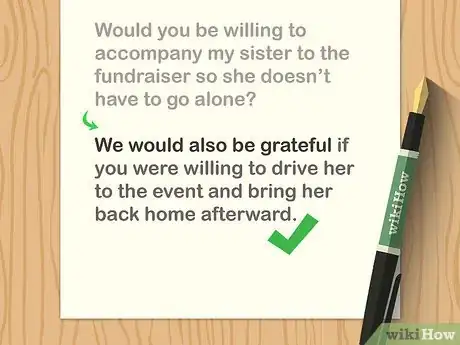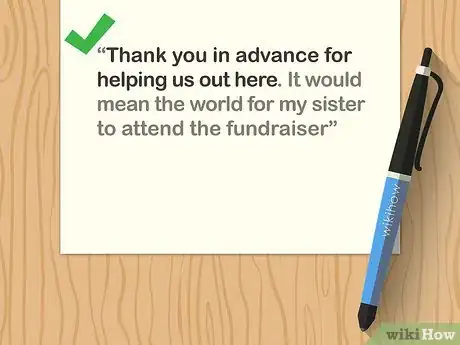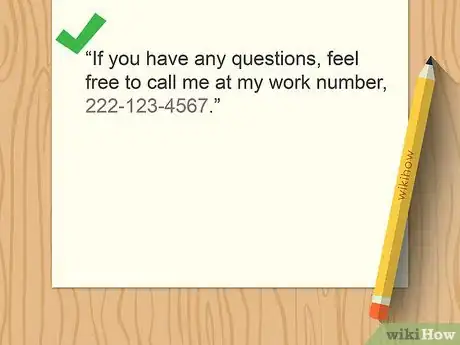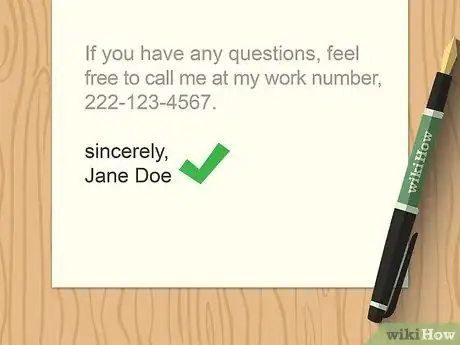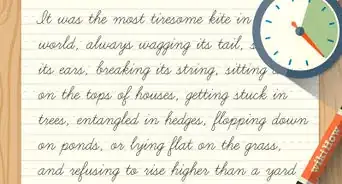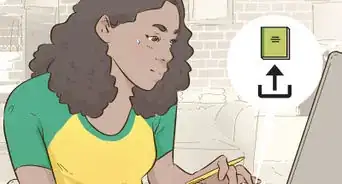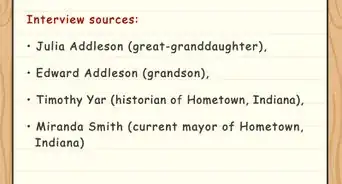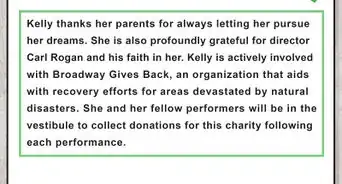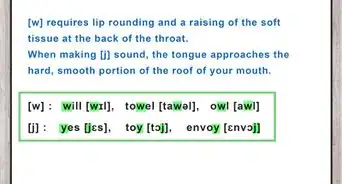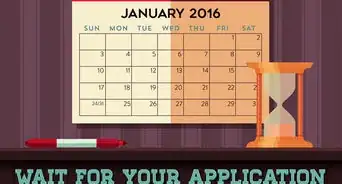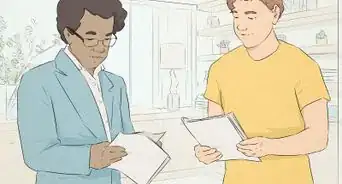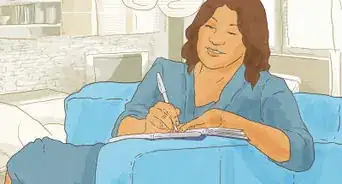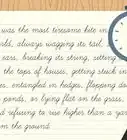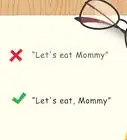This article was co-authored by Shannon O'Brien, MA, EdM and by wikiHow staff writer, Jennifer Mueller, JD. Shannon O'Brien is the Founder and Principal Advisor of Whole U. (a career and life strategy consultancy based in Boston, MA). Through advising, workshops and e-learning Whole U. empowers people to pursue their life's work and live a balanced, purposeful life. Shannon has been ranked as the #1 Career Coach and #1 Life Coach in Boston, MA by Yelp reviewers. She has been featured on Boston.com, Boldfacers, and the UR Business Network. She received a Master's of Technology, Innovation, & Education from Harvard University.
This article has been viewed 126,664 times.
You might write a formal request letter for any number of reasons, including to ask someone for money or other assistance, or to ask that they take a particular action. Your letter should generally be brief – no longer than a page – and explain what you want directly and confidently. How you end your letter depends on the purpose of the letter and the person to whom you're writing. Generally, you would close a personal letter to someone you know more casually than you would close a letter written for a business or professional purpose.[1]
Steps
Examples to End a Letter of Request
Closing a Personal Letter
-
1Use polite language to formulate your request. With a personal letter, you typically provide some background information about why you're making the request, then state your request directly. A phrase such as "would you" or "could you" lets the recipient know that you aren't taking it for granted that they'll fulfill your request.[2]
- For example, you might write "Would you be willing to accompany my sister to the fundraiser so she doesn't have to go alone?"
-
2Start a new paragraph for any follow-up request. If you need a response from the recipient by a certain date, or need them to do anything else related to the request, keep it separate from the main request. This lets the recipient know that the follow-up request is subordinate to the main request.[3]
- To continue with the previous example, a follow-up request might be "We would also be grateful if you were willing to drive her to the event and bring her back home afterward."
Advertisement -
3Thank the recipient in advance for fulfilling your request. After you've stated your request, include a simple statement thanking the recipient. You can also include a sentence about how much their assistance would mean to you.[4]
- For example, you might write "Thank you in advance for helping us out here. It would mean the world for my sister to attend the fundraiser."
-
4Include any additional information the recipient might need. If the request needs to be fulfilled in a specific way, or at a specific time and place, go ahead and include this information after your thanks. You could also include contact information, if you anticipate the recipient will want to talk to you first.[5]
- For example, you might write "My sister would want to get to the fundraiser at least an hour early so she could speak with the organizers."
Tip: If you include additional information, you may also want to add another little line that simply says "thanks again!" This reinforces that you're not taking the recipient's response for granted.
-
5Add a complimentary closing before your name. A simple closing such as "Sincerely yours" works well for personal letters. Depending on how well you know the recipient and the nature of your relationship, you may choose something warmer, such as "Love" or "Love always."[6]
- Type a comma after your closing and leave a double-space for your signature. Then type your name below.
Ending a Business Letter
-
1Include your specific request in the body of the letter. When you're writing a request letter for a business, professional, or academic reason, state the purpose of your letter up front. Preferably, you would include your specific request in the first sentence of your letter, rather than at the end of your letter.[7]
- Because you made your request specifically in the first sentence of your letter, there's no need to repeat it at the end of the letter.
-
2Thank the recipient for their time and attention. Start a new paragraph, then write a single sentence thanking the recipient for taking the time to read your letter and consider your request. The recipient is likely a busy person, and their time is valuable. Let them know that you appreciate them.[8]
- For example, you might write "Thank you for taking the time to consider my request. I really appreciate it."
Tip: After thanking the recipient for their time and attention, you can also add another apology, such as "I apologize for the inconvenience," if appropriate.
-
3Let the recipient know of any deadlines. If you need to know the recipient's answer by a certain date, give them the exact date and time. In some situations, it might be appropriate to provide a brief reason why that deadline is important.[9]
- For example, you might write "I apologize for the short notice, but I do need an answer before Monday, April 22. I have booked a flight out of town on that day, and I'll be away for 2 weeks."
-
4Provide contact information if the recipient has any questions. Give the recipient a way to get in touch with you quickly, particularly if you need an answer within a few days. Make sure the contact method you provide is one at which you're commonly available during regular business hours.[10]
- For example, you might write "If you have any questions, feel free to call me at my work number, 222-123-4567."
-
5Close with a formal and respectful closing. A closing such as "sincerely" or "respectfully" is appropriate for a formal request letter written for a business reason. Type a comma after your closing, then leave a double-space for your signature. Type your signature below the space.[11]
- If any additional information is necessary, such as a job title or identification number, include it on the line directly below your typed name.
Community Q&A
-
QuestionHow do you end a formal letter of request?
 Drew Hawkins1Community AnswerA formal letter of request should be ended professionally. Start a new paragraph, then write a single sentence thanking the recipient for taking the time to read your letter and consider your request. The recipient is likely a busy person, and their time is valuable. Let them know that you appreciate them for their time. If you need to know the recipient's answer by a certain date, give them the exact date and time. Give the recipient a way to get in touch with you quickly, particularly if you need an answer within a few days. Then, close out the letter with a formal closing such as "sincerely" or "respectfully" followed by your name.
Drew Hawkins1Community AnswerA formal letter of request should be ended professionally. Start a new paragraph, then write a single sentence thanking the recipient for taking the time to read your letter and consider your request. The recipient is likely a busy person, and their time is valuable. Let them know that you appreciate them for their time. If you need to know the recipient's answer by a certain date, give them the exact date and time. Give the recipient a way to get in touch with you quickly, particularly if you need an answer within a few days. Then, close out the letter with a formal closing such as "sincerely" or "respectfully" followed by your name. -
QuestionHow do you end an email after asking for something?
 Drew Hawkins1Community AnswerIf you're making a formal request for something by email, you should definitely end it professionally. Even though email may seem like a less formal way to communicate, it's becoming more and more common, so you should still treat it as you would a professional letter. Start a new paragraph and thank the person for their time. If you need them to respond by a certain deadline, make sure you put the date they need to respond by. In some situations, it might be appropriate to provide a brief reason why that deadline is important, such as for an application or for a project deadline. Make sure you give them your contact info so they can reach out if they have any questions or problems. For example, you might write "If you have any questions, feel free to call me at my work number, 222-123-4567." Once you've added that, you can sign off. Use a professional closing like "Sincerely" or "Respectfully." Type a comma after your closing, then leave a double-space for your signature. Type your signature below the space.
Drew Hawkins1Community AnswerIf you're making a formal request for something by email, you should definitely end it professionally. Even though email may seem like a less formal way to communicate, it's becoming more and more common, so you should still treat it as you would a professional letter. Start a new paragraph and thank the person for their time. If you need them to respond by a certain deadline, make sure you put the date they need to respond by. In some situations, it might be appropriate to provide a brief reason why that deadline is important, such as for an application or for a project deadline. Make sure you give them your contact info so they can reach out if they have any questions or problems. For example, you might write "If you have any questions, feel free to call me at my work number, 222-123-4567." Once you've added that, you can sign off. Use a professional closing like "Sincerely" or "Respectfully." Type a comma after your closing, then leave a double-space for your signature. Type your signature below the space. -
QuestionHow do I write a simple letter of request?
 Drew Hawkins1Community AnswerIf you know the person well, you can make the letter a little more personal, which may convince them to do what you're asking. With a personal letter, you typically provide some background information about why you're making the request, then state your request directly. After that, you can start a new paragraph to thank them and close your request. Include a simple statement thanking the recipient. You can also include a sentence about how much their assistance would mean to you. If the request needs to be fulfilled in a specific way, or at a specific time and place, go ahead and include this information after your thanks. Then, you can add a simple closing such as "Sincerely yours" or "Best." Depending on how well you know the recipient and the nature of your relationship, you may choose something warmer, such as "Love" or "Love always." Type a comma after your closing and leave a double-space for your signature. Then type your name below.
Drew Hawkins1Community AnswerIf you know the person well, you can make the letter a little more personal, which may convince them to do what you're asking. With a personal letter, you typically provide some background information about why you're making the request, then state your request directly. After that, you can start a new paragraph to thank them and close your request. Include a simple statement thanking the recipient. You can also include a sentence about how much their assistance would mean to you. If the request needs to be fulfilled in a specific way, or at a specific time and place, go ahead and include this information after your thanks. Then, you can add a simple closing such as "Sincerely yours" or "Best." Depending on how well you know the recipient and the nature of your relationship, you may choose something warmer, such as "Love" or "Love always." Type a comma after your closing and leave a double-space for your signature. Then type your name below.
References
- ↑ https://owl.purdue.edu/owl/general_writing/personal_correspondence/personal_letters.html
- ↑ https://speakspeak.com/resources/general-english-vocabulary/making-requests-in-emails-and-letters
- ↑ https://speakspeak.com/resources/general-english-vocabulary/making-requests-in-emails-and-letters
- ↑ https://www.businesswritingblog.com/business_writing/2009/08/thank-you-in-advance.html
- ↑ https://au.indeed.com/career-advice/career-development/sample-letter-of-request
- ↑ https://owl.purdue.edu/owl/general_writing/personal_correspondence/personal_letters.html
- ↑ https://au.indeed.com/career-advice/career-development/sample-letter-of-request
- ↑ http://go.sdsu.edu/student_affairs/ombudsman/writingletter.aspx
- ↑ http://go.sdsu.edu/student_affairs/ombudsman/writingletter.aspx

